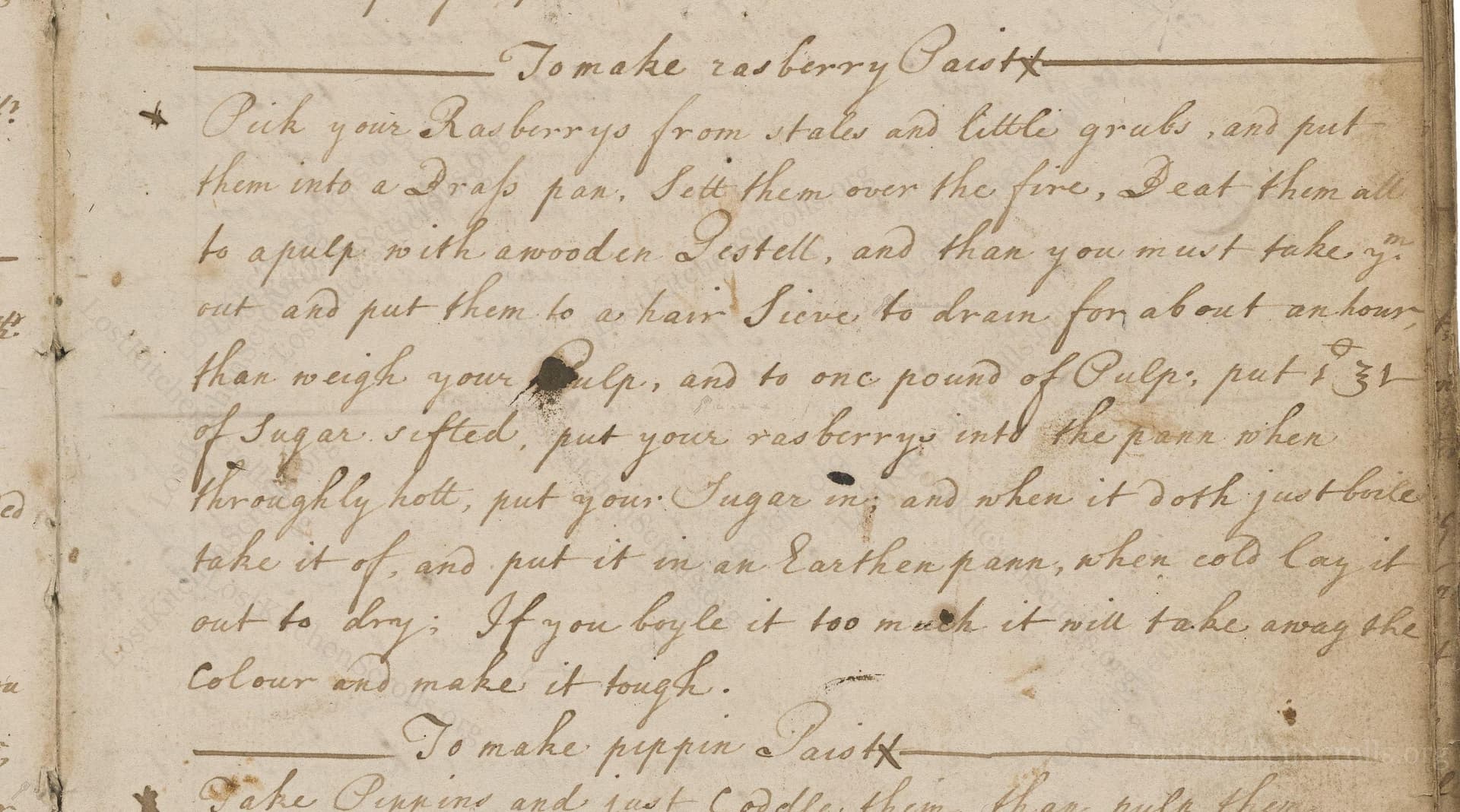To Make Rasberry Paist
From the treasured pages of Receipt book of Dorothy Stone
Written by Dorothy Stone

To Make Rasberry Paist
"Pick your Rasberrys from stalks and little grubs, and put them into a Drap pan, Sett them over the fire, Beat them all to a pulp with a wooden Pestell, and than you must take it out and put them to a hair Sieve, to drain for about an hour than weigh your Pulp, and to one pound of Pulp; put 3l of Sugar sifted, put your rasberry into the pann when throughly hott, put your Sugar in; and when it doth just boyle take it of, and put it in an Earthen pann, when cold Lay it out to dry; If you boyle it too much it will take away the Colour and make it tough."
Note on the Original Text
The technique in this recipe is straightforward and typical of early 18th-century manuscript cookery: direct, with little measurement except by weight after initial processing. The spelling retains period forms ('rasberrys', 'boyle', 'earthen pann'), and instructions are offered in a conversational style. Sugar quantities are specified by weight per pound of fruit pulp, a standard method before modern measuring cups. Clarity in the instructions and sequence relies on assumed kitchen knowledge; terms like 'boyle' (boil) and 'pulp' were well understood. The recipe expects cooks to watch carefully, as cooking time is brief and color preservation is prized.

Title
Receipt book of Dorothy Stone (1725)
You can also click the book image above to peruse the original tome
Writer
Dorothy Stone
Era
1725
Publisher
Unknown
Background
Step into the delicious world of early 18th-century kitchens with Dorothy Stone, where classic recipes and culinary curiosities await. Expect a charming medley of hearty fare, sweet treats, and the tasteful secrets of a bygone era.
Kindly made available by
Folger Shakespeare Library
This recipe comes from a manuscript attributed to Dorothy Stone and dates to around 1725, a time when fruit pastes and preserves were both a luxury and a delight for the English elite. Recipes like this would have been used to create decorative and flavorful treats for dessert tables or to preserve the fleeting bounty of summer raspberries. Sugar, expensive and prized, was used in large quantities as both a sweetener and preservative. Fruit pastes were often made at home since they were rarely available in the market. The process reflects the culinary traditions of early 18th-century Britain, where preserving fruits showcased skill in both horticulture and kitchen craft.

The original recipe required a 'Drap pan' (a shallow pan), a wooden pestle for mashing, and a 'hair sieve'—an early form of fine strainer, often made with horsehair. After mixing, the paste would be dried in a shallow, unglazed earthenware pan or dish in a cool, dry place. Today, you'd use a heavy-bottomed saucepan, a potato masher or spoon, a fine mesh sieve or cheesecloth, and parchment-lined trays or glass dishes for drying.
Prep Time
1 hr 30 mins
Cook Time
10 mins
Servings
40
We've done our best to adapt this historical recipe for modern kitchens, but some details may still need refinement. We warmly welcome feedback from fellow cooks and culinary historians — your insights support the entire community!
Ingredients
- Fresh raspberries, about 2.2 pounds (or as available)
- White granulated sugar, approximately 3 pounds per 1 pound raspberry pulp
Instructions
- Begin by picking over your fresh raspberries, removing any stems or debris, and ensure there are no insects.
- Place the raspberries in a heavy-bottomed saucepan and set over medium-low heat.
- Mash thoroughly with a wooden spoon or potato masher, until you have a juicy pulp.
- Transfer this pulp to a fine mesh sieve or cheesecloth set over a bowl and let it drain for about one hour, allowing much of the juice and seeds to separate from the thick pulp.
- Weigh the resulting strained raspberry pulp.
- For every 1 pound (450 grams) of pulp you have, measure out 3 pounds (1.5 kilograms) of white granulated sugar.
- Clean your saucepan and return the raspberry pulp to it.
- Heat the pulp gently until thoroughly hot but not boiling, then add the sugar all at once.
- Stir constantly, and as soon as the mixture just comes to a simmer or low boil, remove from the heat immediately.
- Transfer to a ceramic or glass dish.
- Let it cool completely, then, using a spatula, lay the paste out onto a parchment-lined tray to dry until firm and sliceable.
- Avoid overboiling—the less time on the heat, the brighter your finished raspberry paste.
- If it's cooked too long, it may become tough and lose its vibrant color.
Estimated Calories
90 per serving
Cooking Estimates
Preparing and straining the raspberries takes most of the time. Cooking is quick because you just need to heat the pulp and sugar until it simmers, then cool and dry the paste. Each serving is about 25g and contains a lot of sugar, so it's quite high in calories.
As noted above, we have made our best effort to translate and adapt this historical recipe for modern kitchens, taking into account ingredients nowadays, cooking techniques, measurements, and so on. However, historical recipes often contain assumptions that require interpretation.
We'd love for anyone to help improve these adaptations. Community contributions are highly welcome. If you have suggestions, corrections, or cooking tips based on your experience with this recipe, please share them below.
Join the Discussion
Rate This Recipe
Dietary Preference
Main Ingredients

Den Bockfisch In Einer Fleisch Suppen Zu Kochen
This recipe hails from a German manuscript cookbook compiled in 1696, a time whe...

Die Grieß Nudlen Zumachen
This recipe comes from a rather mysterious manuscript cookbook, penned anonymous...

Ein Boudain
This recipe comes from an anonymous German-language manuscript cookbook from 169...

Ein Gesaltzen Citroni
This recipe, dating from 1696, comes from an extensive anonymous German cookbook...
Browse our complete collection of time-honored recipes



